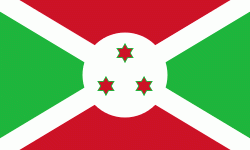Burundian franc
Fr
The franc (ISO 4217 code is BIF) is the currency of Burundi. It is nominally subdivided into 100 centimes, although coins have never been issued in centimes since Burundi began issuing its own currency. Only during the period when Burundi used the Belgian Congo franc were centime coins issued.The franc became the currency of Burundi in 1916, when Belgium occupied the former German colony and replaced the German East African rupie with the Belgian Congo franc. Burundi used the currency of Belgian Congo until 1960, when the Rwanda and Burundi franc was introduced. Burundi began issuing its own francs in 1964.
There were plans to introduce a common currency, a new East African shilling, for the five member states of the East African Community by the end of 2015. As of September 2022, these plans have not yet materialized.
Country
-
Burundi
Burundi, officially the Republic of Burundi (Repuburika y’Uburundi ; Swahili: Jamuhuri ya Burundi; French: République du Burundi ), is a landlocked country in the Great Rift Valley at the junction between the African Great Lakes region and East Africa. It is bordered by Rwanda to the north, Tanzania to the east and southeast, and the Democratic Republic of the Congo to the west; Lake Tanganyika lies along its southwestern border. The capital cities are Gitega and Bujumbura, the latter being the country's largest city.
The Twa, Hutu and Tutsi peoples have lived in Burundi for at least 500 years. For more than 200 of those years, Burundi was an independent kingdom, until the beginning of the 20th century, when it became a German colony. After the First World War and Germany's defeat, the League of Nations "mandated" the territory to Belgium. After the Second World War, this transformed into a United Nations Trust Territory. Both Germans and Belgians ruled Burundi and Rwanda as a European colony known as Ruanda-Urundi. Burundi and Rwanda had never been under common rule until the time of European colonization of Africa.
